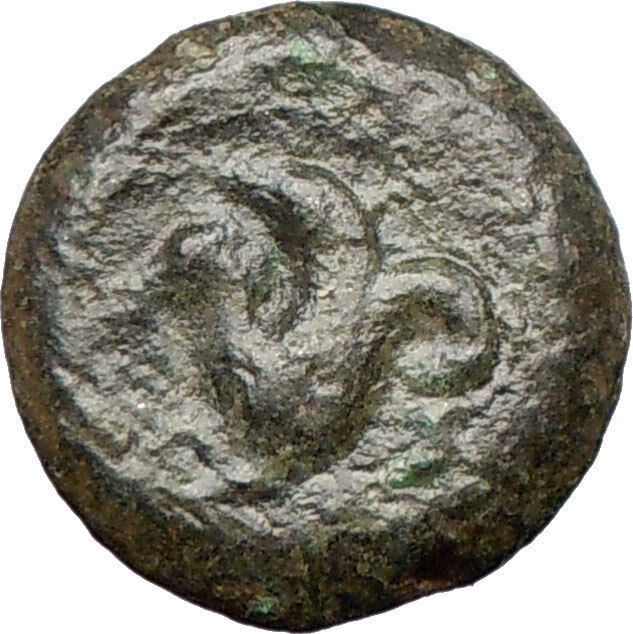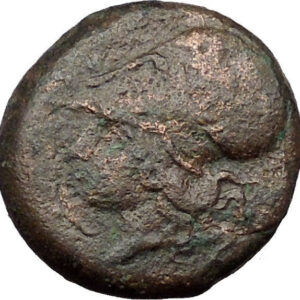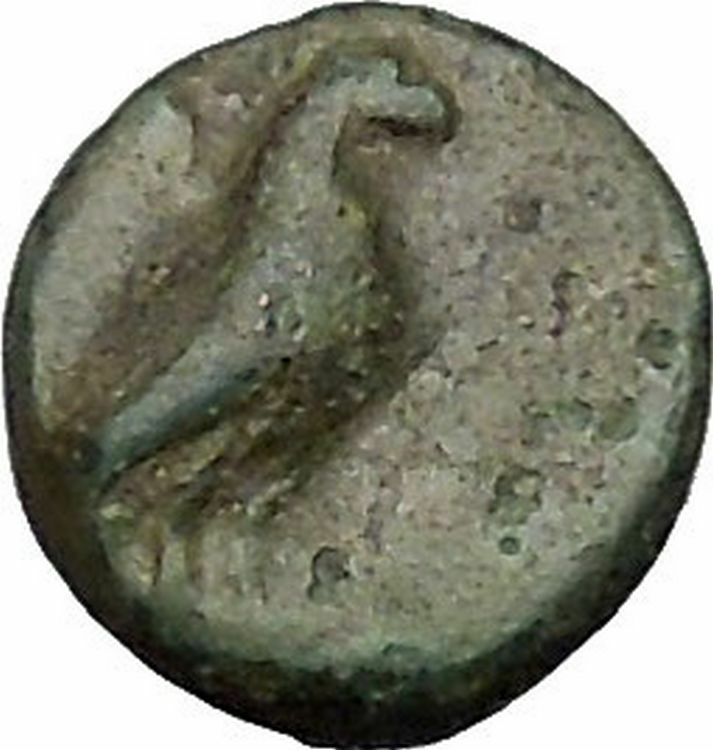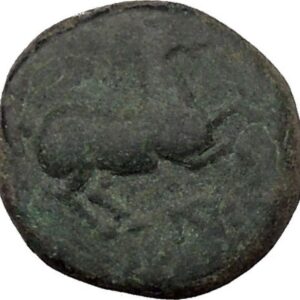|
Greek city of Sardes in Lydia
Bronze 20mm (6.25 grams) Struck circa 133 B.C. – 14 A.D.
Reference: SNG München 463; SNG von Aulock 3129-30; SNG Copenhagen 463 var. (two monograms).
Veiled, draped and turreted bust of Tyche right.
ΣΑΡΔΙΑΝΩΝ, Zeus Lydios standing left, holding sceptre and eagle; monogram to left.
The ancient capital of the Lydian Kings, Sardes lay under a fortified hill in the Hermos valley, at the important road junction. In the pre-Alexandrian age it was the center of the principal Persian satrapy, ad in all probability the mint-place of much of the Persian imperial coinage of darics and sigloi. In 189 B.C. it came under the rule of the Attalids of Pergamon, and fifty-six years later it passes to the Romans.
You are bidding on the exact item pictured, provided with a Certificate of Authenticity and Lifetime Guarantee of Authenticity.
 Tyche (meaning “luck”; Roman equivalent: Fortuna) was the presiding tutelary deity that governed the fortune and prosperity of a city, its destiny. She is the daughter of Aphrodite and Zeus or Hermes. Tyche (meaning “luck”; Roman equivalent: Fortuna) was the presiding tutelary deity that governed the fortune and prosperity of a city, its destiny. She is the daughter of Aphrodite and Zeus or Hermes.
In literature, she might be given various genealogies, as a daughter of Hermes and Aphrodite, or considered as one of the Oceanids, daughters of Oceanus and Tethys, or of Zeus. She was connected with Nemesis and Agathos Daimon (“good spirit”).
The Greek historian Polybius believed that when no cause can be discovered to events such as floods, droughts, frosts or even in politics, then the cause of these events may be fairly attributed to Tyche.
Worship
Increasingly during the Hellenistic period, cities venerated their own specific iconic version of Tyche, wearing a mural crown (a crown like the walls of the city).
Tyche had temples at Caesarea Maritima, Antioch, Alexandria and Constantinople. In Alexandria the Tychaeon, the temple of Tyche, was described by Libanius as one of the most magnificent of the entire Hellenistic world.
She was uniquely venerated at Itanos in Crete, as Tyche Protogeneia, linked with the Athenian Protogeneia (“firstborn”), daughter of Erechtheus, whose self-sacrifice saved the city.
Stylianos Spyridakis concisely expressed Tyche’s appeal in a Hellenistic world of arbitrary violence and unmeaning reverses: “In the turbulent years of the Epigoni of Alexander, an awareness of the instability of human affairs led people to believe that Tyche, the blind mistress of Fortune, governed mankind with an inconstancy which explained the vicissitudes of the time.”
Depictions
Tyche appears on many coins of the Hellenistic period in the three centuries before the Christian era, especially from cities in the Aegean. Unpredictable turns of fortune drive the complicated plotlines of Hellenistic romances, such as Leucippe and Clitophon or Daphnis and Chloe. She experienced a resurgence in another era of uneasy change, the final days of publicly sanctioned Paganism, between the late-fourth-century emperors Julian and Theodosius I who definitively closed the temples. The effectiveness of her capricious power even achieved respectability in philosophical circles during that generation, though among poets it was a commonplace to revile her for a fickle harlot.
In medieval art, she was depicted as carrying a cornucopia, an emblematic ship’s rudder, and the wheel of fortune, or she may stand on the wheel, presiding over the entire circle of fate.
The constellation of Virgo is sometimes identified as the heavenly figure of Tyche, as well as other goddesses such as Demeter and Astraea.
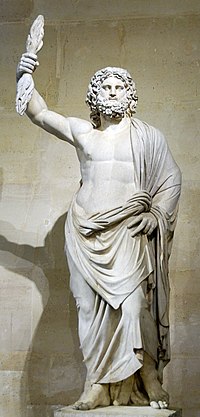 In the ancient Greek religion, Zeus was the “Father of Gods and men” who ruled the Olympians of Mount Olympus as a father ruled the family. He was the god of sky and thunder in Greek mythology. His Roman counterpart is Jupiter and Etruscan counterpart is Tinia. In the ancient Greek religion, Zeus was the “Father of Gods and men” who ruled the Olympians of Mount Olympus as a father ruled the family. He was the god of sky and thunder in Greek mythology. His Roman counterpart is Jupiter and Etruscan counterpart is Tinia.
Zeus was the child of Cronus and Rhea, and the youngest of his siblings. In most traditions he was married to Hera, although, at the oracle of Dodona, his consort was Dione: according to the Iliad, he is the father of Aphrodite by Dione. He is known for his erotic escapades. These resulted in many godly and heroic offspring, including Athena, Apollo and Artemis, Hermes, Persephone (by Demeter), Dionysus, Perseus, Heracles, Helen of Troy, Minos, and the Muses (by Mnemosyne); by Hera, he is usually said to have fathered Ares, Hebe and Hephaestus.
As Walter Burkert points out in his book, Greek Religion, “Even the gods who are not his natural children address him as Father, and all the gods rise in his presence.” For the Greeks, he was the King of the Gods, who oversaw the universe. As Pausanias observed, “That Zeus is king in heaven is a saying common to all men”. In Hesiod’s Theogony Zeus assigns the various gods their roles. In the Homeric Hymns he is referred to as the chieftain of the gods.
His symbols are the thunderbolt, eagle, bull, and oak. In addition to his Indo-European inheritance, the classical “cloud-gatherer” also derives certain iconographic traits from the cultures of the Ancient Near East, such as the scepter. Zeus is frequently depicted by Greek artists in one of two poses: standing, striding forward, with a thunderbolt leveled in his raised right hand, or seated in majesty.
 Sardis or Sardes was an ancient city at the location of modern Sart (Sartmahmut before 19 October 2005) in Turkey’s Manisa Province. Sardis was the capital of the ancient kingdom of Lydia, one of the important cities of the Persian Empire, the seat of a proconsul under the Roman Empire, and the metropolis of the province Lydia in later Roman and Byzantine times. As one of the Seven churches of Asia, it was addressed by the author John of the Book of Revelation in the Holy Bible in terms which seem to imply that its population was notoriously soft and fainthearted. Its importance was due, first to its military strength, secondly to its situation on an important highway leading from the interior to the Aegean coast, and thirdly to its commanding the wide and fertile plain of the Hermus. Sardis or Sardes was an ancient city at the location of modern Sart (Sartmahmut before 19 October 2005) in Turkey’s Manisa Province. Sardis was the capital of the ancient kingdom of Lydia, one of the important cities of the Persian Empire, the seat of a proconsul under the Roman Empire, and the metropolis of the province Lydia in later Roman and Byzantine times. As one of the Seven churches of Asia, it was addressed by the author John of the Book of Revelation in the Holy Bible in terms which seem to imply that its population was notoriously soft and fainthearted. Its importance was due, first to its military strength, secondly to its situation on an important highway leading from the interior to the Aegean coast, and thirdly to its commanding the wide and fertile plain of the Hermus.
Geography
Sardis was situated in the middle of Hermus valley, at the foot of Mount Tmolus, a steep and lofty spur which formed the citadel. It was about 4 kilometres (2.5 mi) south of the Hermus. Today, the site is located by the present day village of Sart, near Salihli in the Manisa province of Turkey, close to the Ankara – İzmir highway (approximately 72 kilometres (45 mi) from İzmir). The part of remains including the bath-gymnasium complex, synagogue and Byzantine shops is open to visitors year-round.
History
The earliest reference to Sardis is in the The Persians of Aeschylus (472 BC); in the Iliad, the name Hyde seems to be given to the city of the Maeonian (i.e. Lydian) chiefs, and in later times Hyde was said to be the older name of Sardis, or the name of its citadel. It is, however, more probable that Sardis was not the original capital of the Maeonians, but that it became so amid the changes which produced the powerful Lydian empire of the 8th century BC.
The city was captured by the Cimmerians in the 7th century BC, by the Persians in the 6th, by the Athenians in the 5th, and by Antiochus III the Great at the end of the 3rd century BC. In the Persian era, Sardis was conquered by Cyrus the Great and formed the end station for the Persian Royal Road which began in Persepolis, capital of Persia. During the Ionian Revolt, the Athenians burnt down the city. Sardis remained under Persian domination until it surrendered to Alexander the Great in 334 BC.
The early Lydian kingdom was very advanced in the industrial arts and Sardis was the chief seat of its manufactures. The most important of these trades was the manufacture and dyeing of delicate woolen stuffs and carpets. The stream Pactolus which flowed through the market-place “carried golden sands” in early antiquity, which was in reality gold dust out of Mount Tmolus. It was during the reign of King Croesus that the metallurgists of Sardis discovered the secret of separating gold from silver, thereby producing both metals of a purity never known before. This was an economic revolution, for while gold nuggets panned or mined were used as currency, their purity was always suspect and a hindrance to trade. Such nuggets or coinage were naturally occurring alloys of gold and silver known as electrum and one could never know how much of it was gold and how much was silver. Sardis now could mint nearly pure silver and gold coins, the value of which could be-and was-trusted throughout the known world. This revolution made Sardis rich and Croesus’ name synonymous with wealth itself. For this reason, Sardis is famed in history as the place where modern currency was invented.
Disaster came to the great city under the reign of the emperor Tiberius, when in AD 17, Sardis was destroyed by an earthquake, but it was rebuilt. It was one of the great cities of western Asia Minor until the later Byzantine period.
Later, trade and the organization of commerce continued to be sources of great wealth. After Constantinople became the capital of the East, a new road system grew up connecting the provinces with the capital. Sardis then lay rather apart from the great lines of communication and lost some of its importance. It still, however, retained its titular supremacy and continued to be the seat of the metropolitan bishop of the province of Lydia, formed in AD 295. It was enumerated as third, after Ephesus and Smyrna, in the list of cities of the Thracesion thema given by Constantine Porphyrogenitus in the 10th century. However, over the next four centuries it was in the shadow of the provinces of Magnesia-upon-Sipylum and Philadelphia, which retained their importance in the region.
After 1071 the Hermus valley began to suffer from the inroads of the Seljuk Turks but the Byzantine general John Doukas reconquered the city in 1097, the successes of the general Philokales in 1118 relieved the district from later Turkish pressure and the ability of the Comneni dynasty together with the gradual decay of the Seljuk Sultanate of Rum meant that it remained under Byzantine dominion. When Constantinople was taken by the Venetians and Franks in 1204 Sardis came under the rule of the Byzantine Empire of Nicea. However once the Byzantines retook Constantinople in 1261, Sardis with the entire Asia Minor was neglected and the region eventually fell under the control of Ghazi (Ghazw) emirs, the Cayster valleys and a fort on the citadel of Sardis was handed over to them by treaty in 1306. The city continued its decline until its capture (and probable destruction) by the Mongol warlord Timur in 1402.
|





 Tyche (meaning “luck”; Roman equivalent: Fortuna) was the presiding tutelary deity that governed the fortune and prosperity of a city, its destiny. She is the daughter of Aphrodite and Zeus or Hermes.
Tyche (meaning “luck”; Roman equivalent: Fortuna) was the presiding tutelary deity that governed the fortune and prosperity of a city, its destiny. She is the daughter of Aphrodite and Zeus or Hermes. In the ancient Greek religion, Zeus was the “Father of Gods and men” who ruled the Olympians of Mount Olympus as a father ruled the family. He was the god of sky and thunder in Greek mythology. His Roman counterpart is Jupiter and Etruscan counterpart is Tinia.
In the ancient Greek religion, Zeus was the “Father of Gods and men” who ruled the Olympians of Mount Olympus as a father ruled the family. He was the god of sky and thunder in Greek mythology. His Roman counterpart is Jupiter and Etruscan counterpart is Tinia. Sardis or Sardes was an ancient city at the location of modern Sart (Sartmahmut before 19 October 2005) in Turkey’s Manisa Province. Sardis was the capital of the ancient kingdom of Lydia, one of the important cities of the Persian Empire, the seat of a proconsul under the Roman Empire, and the metropolis of the province Lydia in later Roman and Byzantine times. As one of the Seven churches of Asia, it was addressed by the author John of the Book of Revelation in the Holy Bible in terms which seem to imply that its population was notoriously soft and fainthearted. Its importance was due, first to its military strength, secondly to its situation on an important highway leading from the interior to the Aegean coast, and thirdly to its commanding the wide and fertile plain of the Hermus.
Sardis or Sardes was an ancient city at the location of modern Sart (Sartmahmut before 19 October 2005) in Turkey’s Manisa Province. Sardis was the capital of the ancient kingdom of Lydia, one of the important cities of the Persian Empire, the seat of a proconsul under the Roman Empire, and the metropolis of the province Lydia in later Roman and Byzantine times. As one of the Seven churches of Asia, it was addressed by the author John of the Book of Revelation in the Holy Bible in terms which seem to imply that its population was notoriously soft and fainthearted. Its importance was due, first to its military strength, secondly to its situation on an important highway leading from the interior to the Aegean coast, and thirdly to its commanding the wide and fertile plain of the Hermus.

